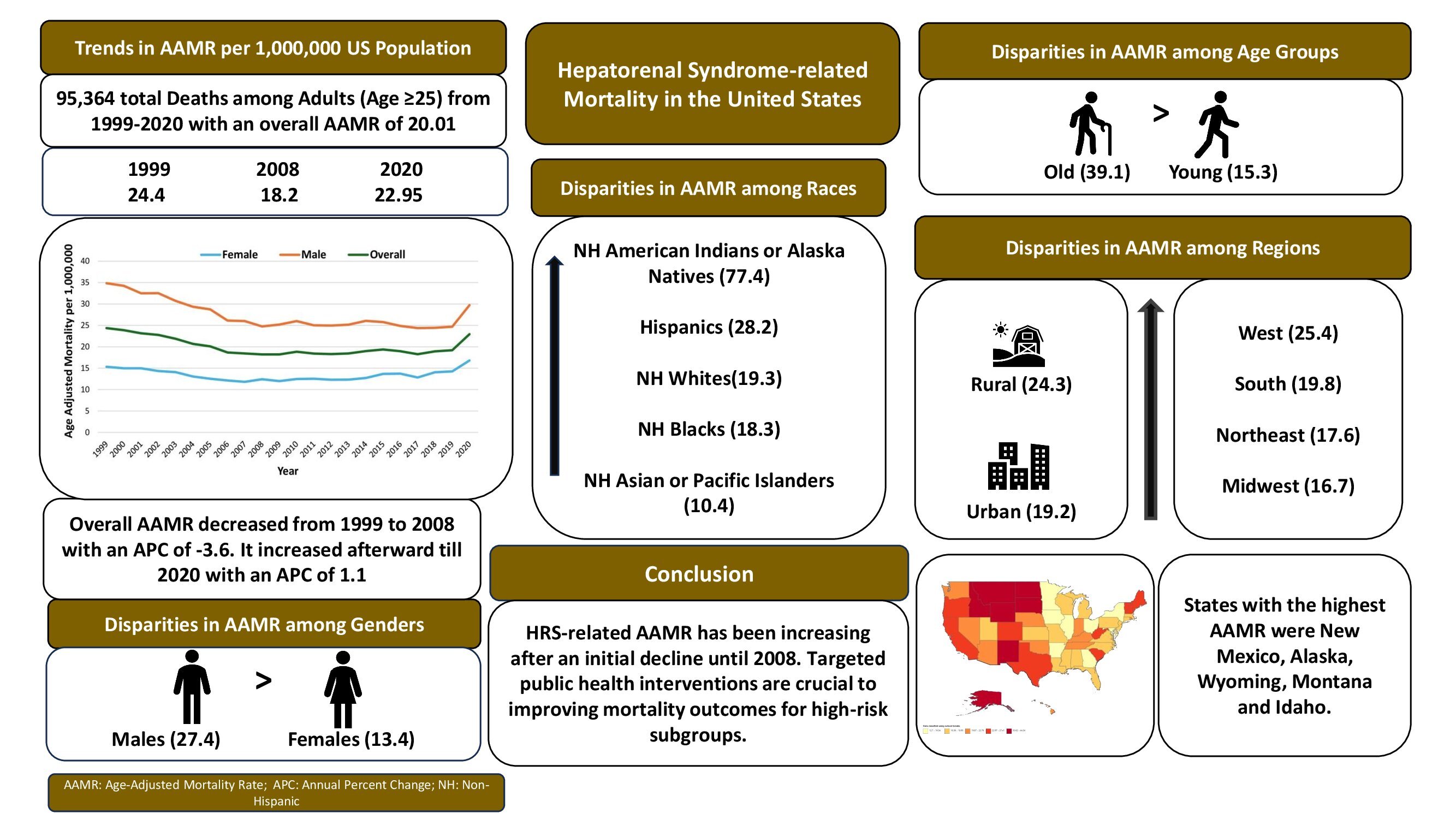Tuesday Poster Session
Category: Liver
P4596 - Trends and Disparities in Hepatorenal Syndrome-Related Mortality in the United States From 1999-2020: A Nationwide Analysis
Tuesday, October 29, 2024
10:30 AM - 4:00 PM ET
Location: Exhibit Hall E

Has Audio

Usama Qamar, MD (he/him/his)
King Edward Medical University
Rochester, MN
Presenting Author(s)
Usama Qamar, MD1, Aamir Saeed, MD2, Waleed Qamar, MBBS1, Sarosh A. Khan, MD3, Muhammad Qasim. Khan, MD4, Ijlal Akbar Ali, MD5
1King Edward Medical University, Lahore, Punjab, Pakistan; 2Vanderbilt University Medical Center, Nashville, TN; 3Integris Baptist Medical Center, Oklahoma City, OK; 4London Health Sciences Center, University of West Ontario, London, ON, Canada; 5University of Oklahoma College of Medicine, Oklahoma City, OK
Introduction: Hepatorenal syndrome (HRS) is a severe complication of advanced liver disease characterized by rapid kidney failure and poor prognosis. This study aims to determine HRS-related mortality trends from 1999 to 2020 among adults in the United States.
Methods: Data from the Centers for Disease Control and Prevention’s Wide-Ranging Online Data for Epidemiologic Research (CDC WONDER) database was retrieved to identify all the fatalities where HRS was listed as an underlying or contributing cause of death. Age-adjusted mortality rates (AAMRs) per 1 million individuals were quantified and temporal mortality trends were evaluated by calculating annual percent changes (APC) in AAMR using the Joinpoint regression model.
Results: There was a total of 95,364 HRS-related deaths among adults aged ≥25 years in the US between 1999 and 2020, with a cumulative overall AAMR of 20.01. The overall AAMR underwent a significant decline from 1999-2008 (APC: -3.6; p< 0.01) and then increased significantly till 2020 (APC: 1.1; p< 0.01). Males had a cumulative AAMR that was twice that of females (27.4 vs 13.4, respectively). AAMRs in both genders declined significantly till 2008; then remained stable in males but underwent a significant rise till 2020 in females. Older adults aged ≥65 years (39.1) had a higher cumulative AAMR than younger adults aged 25-64 years (15.3). Non-Hispanic (NH) American Indians/Alaska Natives (77.4) had substantially higher AAMRs than Hispanics/Latinos (28.2), NH Whites (19.3), NH Blacks/African Americans (18.3), and NH Asians/Pacific Islanders (10.4). AAMRs in all races declined over the study duration except NH American Indians/Alaska Natives, where AAMR has been on a constant rise (APC: 1.8; p< 0.01). Rural areas (24.3) had higher AAMR than urban areas (19.2), while the West region had the highest cumulative AAMR (25.4), followed by the South (19.8), Northeast (17.6), and Midwestern (16.7) regions.
Discussion: HRS-related AAMR has been increasing after an initial decline until 2008, especially in females and NH American Indians/Alaska Natives. The increased mortality observed after 2008 may be attributed to a rise in binge drinking, socioeconomic stressors, and healthcare challenges exacerbated by the economic instability. Further research is needed to pinpoint the exact causes behind increasing mortality and initiate targeted interventions.

Disclosures:
Usama Qamar, MD1, Aamir Saeed, MD2, Waleed Qamar, MBBS1, Sarosh A. Khan, MD3, Muhammad Qasim. Khan, MD4, Ijlal Akbar Ali, MD5. P4596 - Trends and Disparities in Hepatorenal Syndrome-Related Mortality in the United States From 1999-2020: A Nationwide Analysis, ACG 2024 Annual Scientific Meeting Abstracts. Philadelphia, PA: American College of Gastroenterology.
1King Edward Medical University, Lahore, Punjab, Pakistan; 2Vanderbilt University Medical Center, Nashville, TN; 3Integris Baptist Medical Center, Oklahoma City, OK; 4London Health Sciences Center, University of West Ontario, London, ON, Canada; 5University of Oklahoma College of Medicine, Oklahoma City, OK
Introduction: Hepatorenal syndrome (HRS) is a severe complication of advanced liver disease characterized by rapid kidney failure and poor prognosis. This study aims to determine HRS-related mortality trends from 1999 to 2020 among adults in the United States.
Methods: Data from the Centers for Disease Control and Prevention’s Wide-Ranging Online Data for Epidemiologic Research (CDC WONDER) database was retrieved to identify all the fatalities where HRS was listed as an underlying or contributing cause of death. Age-adjusted mortality rates (AAMRs) per 1 million individuals were quantified and temporal mortality trends were evaluated by calculating annual percent changes (APC) in AAMR using the Joinpoint regression model.
Results: There was a total of 95,364 HRS-related deaths among adults aged ≥25 years in the US between 1999 and 2020, with a cumulative overall AAMR of 20.01. The overall AAMR underwent a significant decline from 1999-2008 (APC: -3.6; p< 0.01) and then increased significantly till 2020 (APC: 1.1; p< 0.01). Males had a cumulative AAMR that was twice that of females (27.4 vs 13.4, respectively). AAMRs in both genders declined significantly till 2008; then remained stable in males but underwent a significant rise till 2020 in females. Older adults aged ≥65 years (39.1) had a higher cumulative AAMR than younger adults aged 25-64 years (15.3). Non-Hispanic (NH) American Indians/Alaska Natives (77.4) had substantially higher AAMRs than Hispanics/Latinos (28.2), NH Whites (19.3), NH Blacks/African Americans (18.3), and NH Asians/Pacific Islanders (10.4). AAMRs in all races declined over the study duration except NH American Indians/Alaska Natives, where AAMR has been on a constant rise (APC: 1.8; p< 0.01). Rural areas (24.3) had higher AAMR than urban areas (19.2), while the West region had the highest cumulative AAMR (25.4), followed by the South (19.8), Northeast (17.6), and Midwestern (16.7) regions.
Discussion: HRS-related AAMR has been increasing after an initial decline until 2008, especially in females and NH American Indians/Alaska Natives. The increased mortality observed after 2008 may be attributed to a rise in binge drinking, socioeconomic stressors, and healthcare challenges exacerbated by the economic instability. Further research is needed to pinpoint the exact causes behind increasing mortality and initiate targeted interventions.

Figure: Hepatorenal Syndrome-related Mortality Among Adults in the United States, 1999-2020.
Disclosures:
Usama Qamar indicated no relevant financial relationships.
Aamir Saeed indicated no relevant financial relationships.
Waleed Qamar indicated no relevant financial relationships.
Sarosh Khan indicated no relevant financial relationships.
Muhammad Khan indicated no relevant financial relationships.
Ijlal Akbar Ali indicated no relevant financial relationships.
Usama Qamar, MD1, Aamir Saeed, MD2, Waleed Qamar, MBBS1, Sarosh A. Khan, MD3, Muhammad Qasim. Khan, MD4, Ijlal Akbar Ali, MD5. P4596 - Trends and Disparities in Hepatorenal Syndrome-Related Mortality in the United States From 1999-2020: A Nationwide Analysis, ACG 2024 Annual Scientific Meeting Abstracts. Philadelphia, PA: American College of Gastroenterology.
